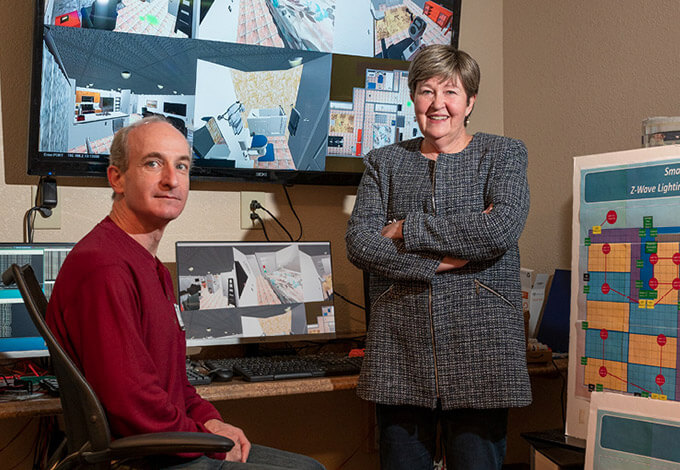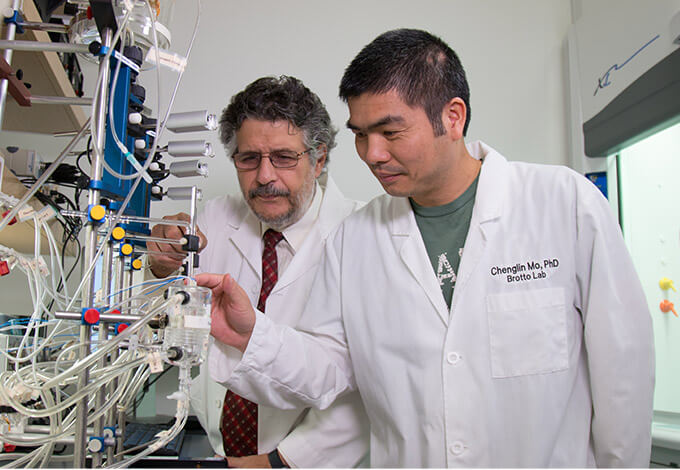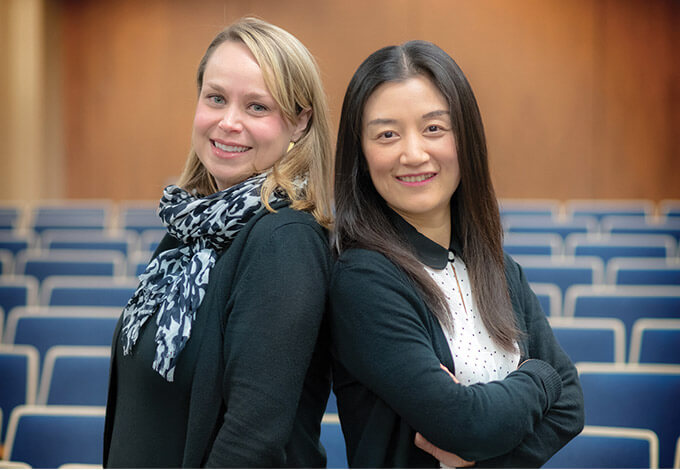America is aging—fast. In just over a decade, the number of people over the age of 65 is expected to outnumber children under 18, according to the U.S. Census Bureau.
By 2060, nearly one in four Americans will be 65 years and older, the number of people 85 and older will triple, and the country will have added a half-million centenarians. As this demographic grows, so will the demand for improved health care and expertise in elder care.
UTA is cultivating both, with an interdisciplinary focus growing in scope and reach, spanning the College of Nursing and Health Innovation (CONHI), School of Social Work, College of Engineering, and College of Science. Support for the work is substantial, with UTA receiving significant funding to accelerate both personnel and research in the gerontology field.
“Think of all of the medical breakthroughs of the past century, from antibiotics to hip replacements,” says Kathryn Daniel, associate dean for academic affairs in CONHI and a nursing and gerontology expert. “Those breakthroughs mean that people are surviving and thriving well into older age. Health care has to keep up.”
Advanced Health Care
The health care needs of a 40-year-old differ vastly from the needs of an 80-year-old. Yet for too long, those differences have not been adequately reflected by the health care industry.
Dr. Daniel wants to change that. She has worked in elder health care for nearly 40 years, from geriatric primary care to long-term care and assisted living facilities. These days, her professional mission is to prepare the next generation of nurses for the same work.
By doing so, Daniel is positioning CONHI as a leader in adult gerontology nursing.
Social Isolation
Social work research aims to ease the physical and emotional effects of loneliness.
“Our older population deserves the most compassionate and knowledgeable health care possible,” Daniel says. “We are trying to fill that need by training UTA students to understand and address the specific health needs of older adults.”
Community and philanthropic organizations have long taken notice of UTA’s prominent role in gerontology. The Moritz family was one of the early investors in accelerating UTA’s work in elder care when it established the Moritz Chair in Geriatrics. The family’s investment, combined with philanthropic support from donors who created graduate fellowships in the field, has helped fuel the University’s steady growth in elder care research over the past decade.
More recently, the Deerbrook Charitable Trust gave UTA a transformational $4.7 million gift, recognizing the need for more skilled professionals to care for older adults.
In addition to significantly expanding opportunities for nursing professionals to work in elder care, the trust helped UTA launch a new graduate-level gerontology health care certificate program for health care professionals who work with adults 65 and older.

Kathryn Daniel and computer science and engineering Professor Manfred Huber in the control room of the Smart Care Apartment, a tech-enhanced living space designed to help older individuals remain healthy and independent
The program is open to health care professionals who work in a variety of settings, from hospitals and home health to skilled-nursing facilities and assisted-living centers. Students in the program study elder care in the U.S. and countries worldwide, heart failure and exercise rehabilitation, aging policy and social justice, and death and dying.
“We tackle weighty issues, such as end-of-life care, that are critical for health care professionals to understand,” Daniel says. “Death can be a difficult subject, but we have to address it so we can provide excellent, evidence-based care throughout all stages of life.”
The new certificate program is in addition to UTA’s Adult-Gerontology Nurse Practitioner program, which prepares advanced practice nurses to manage the complex health needs of older adults.
Our older population deserves the most compassionate and knowledgeable health care possible.
The University also recently broke ground on a $76 million facility that will bring together CONHI’s Smart Hospital and the School of Social Work, enhancing opportunities for collaboration between the fields.
The Smart Hospital allows students to practice and perfect nursing and clinical skills while working with technologically advanced, simulated patients. Instruction provides the building blocks necessary to support older patients. Notable spaces include a home-health environment—a space that looks identical to a home, essential for a simulated learning environment for nurses and case workers who work with the elderly—and a dedicated virtual reality room where students can address a variety of simulation scenarios.
“This new building will greatly benefit our nursing students and other clinical students by providing them access to greater clinical simulation experiences as a part of their clinical education,” says Elizabeth Merwin, dean of CONHI. “Those students will become the health care workforce for the future, and they will graduate from UTA knowing they received the finest education to address patient needs.”
It’s all in service of the greater goal, which is to ensure that nurses have a robust skillset allowing them to provide superlative holistic care to our aging population.
“Older adults have a lived experience that is so rich and varied. They have been part of history in ways that many of us can only imagine,” Daniel says. “They are complex and multifaceted. As health care professionals, we must embrace the complexity and richness of interpersonal relationships because they will always be part of the care for older adults.”
Precision medicine and osteoporosis
Bones are living tissue, constantly broken down and replaced. But in osteoporosis, the creation of new bone does not keep up with the loss of old.
Some 200 million people suffer from osteoporosis, which most frequently results in fractures to the wrist, hip, and spine. Women are far more likely than men to develop the condition. Despite its ubiquity, osteoporosis is sometimes called a silent disease because people frequently do not know they have it until a bone fractures, seemingly without warning.
Weaker Bones
Breaks caused by osteoporosis can be subtle. With earlier detection, UTA researchers hope to prevent more extreme damage later.
But what if there were a way to screen for the disease decades earlier?
“Osteoporosis is one of the most common and devastating chronic aging conditions,” says Marco Brotto, George W. and Hazel M. Jay Professor in CONHI and director of the Bone-Muscle Research Center. “Earlier diagnosis could be a game changer.”
With that in mind, Dr. Brotto and a team of researchers set out to study blood samples from 222 women, ages 20 to 80, including those who have osteoporosis and others who do not and some with and without fractures.
Their landmark study, published in Nature Communications Biology, detailed a series of biomarkers in the blood that could be associated with osteoporosis and a quick, accurate, and sensitive screening method to quantify them, demonstrating the test’s clinical applications.
“We are quickly entering an era of precision medicine in which disease prevention and treatment will be highly personalized depending on a person’s genetics and other blood biomarkers,” Brotto says. “This is a prime example of precision medicine.”

Marco Brotto and Chenglin Mo at work in the lab.
The National Institutes of Health and the National Institute on Aging provided crucial support to the project, along with colleagues at Tulane University, Indiana University, and Creighton University’s Osteoporosis Research Center.
Now, the team is expanding its study to include more women, enabling researchers to evaluate body mass index, the effect of exercise versus a sedentary lifestyle, different countries of origins, and various races and ethnicities.
“We are still diagnosing osteoporosis with X-rays, a method we’ve been using since 1963,” says Brotto. “But this is the 21st century, and it’s time we have 21st-century diagnostic tools. My goal is to develop an entirely new diagnostic kit for osteoporosis. This work could lead to improved interventions with nutrition, physical therapy, and new or repurposed drugs.”
Diagnosing Alzheimer’s Disease
In Alzheimer’s patients, the brain shrinks. As the disease progresses, a patient develops more severe memory loss and cognitive decline, eventually leaving them unable to complete everyday tasks.
Like osteoporosis, what if Alzheimer’s could be detected earlier, helping to tailor treatment to slow or prevent the disease from progressing?
Won Hwa Kim, an assistant professor of computer science, is exploring how artificial intelligence (AI) could help identify variations in the brain to predict Alzheimer’s in patients.
Dr. Kim hopes to develop a novel AI technique that uses algorithms that mimic the structure and function of networks in the brain, comparing people who have Alzheimer’s to others who do not.
Previous studies have focused on identifying which brain regions are related to which functions. Kim’s project will instead delve into the relationships between different brain regions, requiring sophisticated analysis methods for brain networks.
“Society is getting older as people live longer. But rather than to simply live longer, it is very important to improve the quality of life for elders and caregivers,” Kim says. “We all will be old someday.”
Combating social isolation and loneliness
Loneliness and social isolation come with a heavy price. Social isolation is linked to increased risk of dementia, heart disease, stroke, high blood pressure, a weakened immune system, and anxiety and depression.
That’s troubling because one-fourth of adults 65 and older are considered socially isolated, according to the National Academies of Science, Engineering, and Medicine. And the COVID-19 pandemic has worsened loneliness and social isolation among all age groups, including seniors who are most at risk from getting sick from the virus.
Two social work professors, Ling Xu and Noelle Fields, are exploring how to use reminiscence therapy and digital storytelling to ease loneliness and social isolation.
“Humans are wired for social connection, and these social connections have a powerful influence on our overall health and well-being,” Dr. Xu says. “Forming strong social networks can also help us as we grow older to stay healthy and happy.”
The project will pair UTA students with older adults who have early-stage dementia, and the pairs will talk weekly about careers, families, and major life events. Students will create digital projects incorporating music and stories that document their partner’s memories.
UTA is working with Meals on Wheels in Tarrant County to identify potential participants.
Such dialogues are traditionally conducted by social workers and health care professionals, but a shortage of trained professionals provided a unique opportunity for UTA students.

Noelle Fields and Ling Xu
A control group in the project also will talk weekly, but without using reminiscence therapy or digital storytelling, to compare the outcomes.
RRF Foundation for Aging is providing funding for the two-year project, which will begin this year.
“Social distancing does not mean social isolation,” Dr. Fields says, “It’s more important than ever that we find meaningful ways to stay connected with others.”
Healthy, active lifestyles
It is difficult to overstate the importance of regular physical activity in older adults.
Exercise can delay, prevent, or help manage many common chronic conditions, such as diabetes and heart disease.
Yet 31 million adults aged 50 and older are inactive, according to the U.S. Centers for Disease Control and Prevention.
Society is getting older as people live longer. But rather than to simply live longer, it is very important to improve the quality of life for elders and caregivers.
Why? And how do we change that?
Kate Hyun, an assistant professor of civil engineering, is leading a cross-disciplinary research group to examine how technology can help people become more active, particularly those who have become sedentary during the pandemic.
The first part of the project will use methods of persuasion, like texts, emails, and automated voice messages, to increase physical activity.
During the second phase, participants will be given smartphone apps equipped with interactive modules developed by the team. The apps will use gaming, like Pokémon Go, and social media to set daily goals and interaction. For example, participants could be asked to walk one mile then take a photo of something in nature or join a Zumba class by Zoom.
“We want to first understand the barriers older adults face with exercise,” Dr. Hyun says. “And then we want to learn what is most successful to help nudge them toward physical activity.”
The W.W. Caruth Jr. Fund of Communities Foundation of Texas is supporting the work, which includes civil engineering, computer science, kinesiology, psychology, and social work.
Researchers are partnering with senior centers and churches in North Texas to identify participants. The project will focus on low-income areas, where health disparities are the most prevalent.
“Adopting a healthy, active lifestyle has major benefits,” Hyun says. “It’s not simply about living longer. It’s about living longer, healthier.”
Through its far-reaching work in gerontology, UTA is helping older adults do just that. uta


